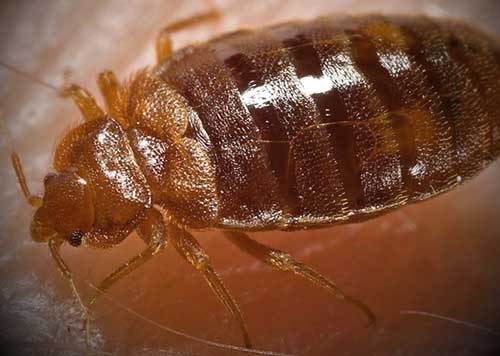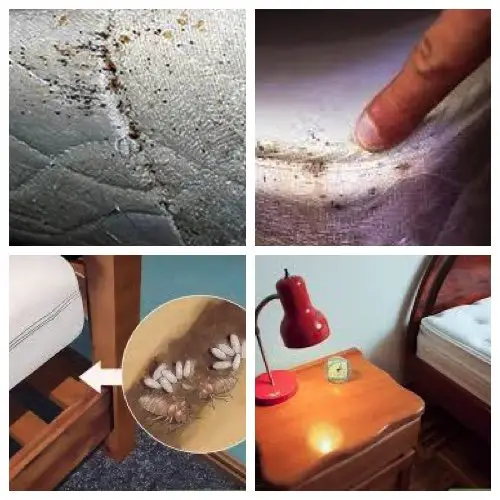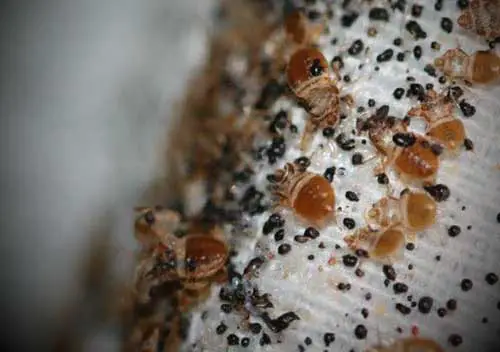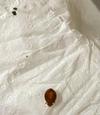Where do bed bugs hide
Bed bugs hide in the room where they were carried by a potential host. They tend to be in places where someone would sleep such as in a bed or chair. Look for signs such as the actual insects, blood stains, eggs or droppings. Check 10 to 20 feet from where you sit or sleep (bed bugs tend to move a very short distance from where they were carried into a room.)
 Adult Bed bugs can be seen with the naked eye and are about the size of an apple seed (adults are 1/8" to 1/4" long). Baby bed bugs are about the size of a poppy seed when newly hatched (under 1/10").
Adult Bed bugs can be seen with the naked eye and are about the size of an apple seed (adults are 1/8" to 1/4" long). Baby bed bugs are about the size of a poppy seed when newly hatched (under 1/10").
where do Bed bugs hide during the day?
Bed bugs hide in thin crevices in dark areas such as mattress seams or bed frame joints during the day. As hiding places become populated they spread to other nearby items such as night stands.
 Bed Bug hide during the day in credit card width crevices closest to the human host
Bed Bug hide during the day in credit card width crevices closest to the human hostBed bug behavior
To know where bedbugs hide, you should know just a little regarding their behavior. They're stealthy creatures that feast upon blood. Bedbugs do not have nests but tend to live in groups. They usually only come out while you are sleeping, simply to feed. When they have had their meal, they scurry to their hiding places until it is time to allow them to make another food run.
Bedbugs may enter your house undetected through luggage, clothing, used beds and couches, along with other products. Their flattened physiques make it easy for them to squeeze into small spaces.
Typically, they hide close to the meal source, so you'll usually locate them near the places they spend prolonged amounts of time. As the invasion grows, they do have a tendency to spread farther away from the primary feeding area.
This guide will help you identify all of the bed bug hiding spots.
Where will I find bed bugs if my home is infested?
Bedbugs prefer to travel and therefore are good hitchhikers. Typical bed bug hiding places include suitcases, boxes, and footwear to be near a food source. They're elusive, nocturnal creatures.
They can hide behind baseboards as well as in cracks, crevices, and folded regions of bedding, beds, and adjacent furniture, especially mattresses and box springs. Bedbugs may also hide in electrical switch plates, mirrors, wallpaper and nearly anywhere in the home, vehicle, bus, or any other shelter. Even though bedbugs usually emerge during the night for a meal, they're opportunistic insects and may come out to look for food throughout the day, particularly in heavily-infested areas.
Bedbugs usually require 5-ten minutes to engorge with the bloodstream. After feeding, they proceed to secluded places and conceal for five to ten days. During this period within the bedbug existence cycle, they don't feed but rather digest their meal, mate, and lay eggs. With time, however, they might scatter with the bedroom, getting into any crevice or protected location. They might also spread to nearby rooms or apartments.
 Bed Bug Nymphs (baby bed bugs) and Feces Stains on Fabric
Bed Bug Nymphs (baby bed bugs) and Feces Stains on Fabricinsects that look like bed bugs
Bed bugs are often confused with insects that appear to look similar such as carpet beetles, cockroach nymphs, and carpet beetles. We suggest confirming that you actually have an infestation by contacting an exterminator (the HomeAdvisor Network - (888) 214-8380 makes it easy) or sending a sample insect to the Cornell Laboratory for identification.
 Once your find an insect, contact an exterminator to confirm that it is in fact a bed bug and not an insect that has a similar appearance such as those show above.
Once your find an insect, contact an exterminator to confirm that it is in fact a bed bug and not an insect that has a similar appearance such as those show above.Tools for finding bed bugs
While you can see bed bugs with the naked eye, it helps to have a few tools:
- Flashlight to see in the dark crevices where bed bugs hide. We suggest a blight white LED flashlight. Bed bug eggs are more easily seen with an ultraviolet flashlight (black light).
- Magnifying glass
- Collection container to hold any insect you find for identification. To preserve the insect fill the container with either rubbing alcohol or a alcohol based hand sanitizer.
- Tweezers or forceps to collect insects
- Crevice tool to inspect tight places such as a credit card, spatula or putty knife. You can also use compressed air in crevices to flush out the insects.
- Vacuum
You can also purchase a bed bug home inspection kit for under $20 for most of the items listed above.
Where to look First
Search the area where there are signs of bed bugs such as mattress stains or where you were bitten. This includes the bedroom or furniture in a family room. Start to look in all thin crevices that are about the width of a credit card. Start your search in typical areas where bed bugs hide include:
- Any furniture near the bed such as the nightstands, in objects on the stands such as magazines, in clock indentations and along headboard seams
- Inside any seams or crevices in furniture
- Check all luggage after traveling
 Bed Bug bites on exposed skin areas when sleeping is one sign that you have a bed bug infestation. Bites are an allergic reaction and are not seen on people that are not allergic.
Bed Bug bites on exposed skin areas when sleeping is one sign that you have a bed bug infestation. Bites are an allergic reaction and are not seen on people that are not allergic.Where Do Bed Bugs Hide in the Bedroom?
In the bedroom start looking for bed bugs at the mattress and then 5 feet in every direction.
To inspect a mattress for bed bugs:
- start along the bottom and top seams
- look along any piping material
- under any handles
- in air holes
- under buttons
- around any tags
To inspect a box spring for bed bugs:
- Check under plastic corner protectors
- Look where the box spring sits on the frame
- Top of box spring
- Remove fabric (or peel it back) on bottom and inspect
- Around any labels
If you live in an apartment building, check adjacent rooms or apartments (next door, above and below yours) for any bed bug conditions.
Other Places to Look for bed bugs in a bedroom:
- Bed frame and head boards (particularly any crevices or indentations such as nail or screw holds
- All joints
- Around the outside of electrical plates (do not insert items into any electrical outlets)
- Check around the floor such as where the floor meets the walls, toys, boxes, books, clothes or backpacks
- Check all zippers around pillows and furniture seams
- Use a crevice tool to check around any art on the walls, mirrors and family photo frames
- Check crevices along smoke detectors and in phones
- Remove all furniture drawers and check inside the drawer tracks and any joints where there may be thin hiding places
 Bed Bug Hiding Places in Bedroom. Beside the bed mattress, box spring, bed frames, and headboard, check nearby furniture, check along any floors for cracks.
Bed Bug Hiding Places in Bedroom. Beside the bed mattress, box spring, bed frames, and headboard, check nearby furniture, check along any floors for cracks.where bed bugs hide in the living room
When inspecting a den or living room look in the seams of all furniture. Check in any ripped areas. Use a something this such as a credit card or putty knife to inspect the crevices.
Be sure to check any edges where carpet meets any walls.
 Bed Bug Hiding Places in Family Room
Bed Bug Hiding Places in Family Roomroom perimeter bed bug hiding places
Bed bugs infestations will move toward the outside edges of the room, such as where walls meet a floor or carpet. Check areas such as:
- Wall and floor edges or crevices near the bed
- Carpet edges
- Under throw or area rugs
- Around electrical and cable wall plates
- All pictures on walls
Surprising places where bedbugs hide
- Clothing
- Bedding
- Curtains
- Luggage, handbags, gym bags and backpacks
- Luggage racks (in rooms in hotels)
- In/around clutter (particularly on the ground)
- Closets (mostly close to the bedroom)
- A coffee table and finish tables (particularly if bedbugs are located inside a nearby sofa or chair)
- Under rugs and also at carpet edges
- Behind/Inside electrical outlets and switch plates
- Behind pictures as well as mirrors
- In wallpaper seams
- Window and door moldings
- Door hinges
- Electronics devices (Mobile Phones, Computers, TVs, etc.)
- Books
- Toy boxes
- Canine beds and dog/Cat cages
- Laundry rooms (from infested clothing laying around)
- Cars
Places Bedbugs Don't Hide
- Kitchens (unless of course, this is your “lounging area”)
- Bathrooms - especially not the bathtub or other ceramic surfaces
- Garages
- Incomplete Basements
- Any rooms that aren't frequently used
Should you choose however locate them during these places, you might have an advanced problem to deal with.
How you can treat a bedbug infestation
Should you awaken with itchy areas you did not have when you went to sleep, you might have bedbugs, specifically, if you had a used bed or any other used furniture at about the time the bites began.
Other signs you have bedbugs include:
- Blood stains on your sheets or pillowcases, mattresses, bed clothes, and walls
- Bed bug fecal spots, eggshells, or shed skins in places that bed bugs hide
- Offensive, musty odor in the bugs' scent glands
If you think you're infested, remove all bedding and handle it carefully not to spread the bed bugs even further. Look at the seams within the wood framing. Peel back the material where it's stapled towards the wood frame. You wouldn't want the inspection itself to result in bedbugs to spread. Here's how to locate bedbugs without making them scatter: Go gradually, and “tread lightly”. Be gentle while you move products. Bear in mind that if your bed is infested, your bed bugs will probably scatter should you upset their hiding places too quickly. Just do a small area at a time and go about it slowly!
Also, look into the area surrounding your bed, including the inside of books, telephones or radios, as well as electrical outlets. Look inside your closet, because bedbugs can affix to clothing.
How will you eliminate bedbugs problems?
If you live in a home that you own and if the infestation is small, you can try killing them yourself. This involves using multiple product and apply those product several times. For instructions and the products you would need, we suggest purchasing them in a bed bug kit.
The typical kit contains insecticides and natural products such as:
- Knock down spray to kill bed bugs on contact
- Residual spray that creates an invisible field to kill any bed busy you might have missed
- Bedbug dust such as the natural product diatomaceous early to also kill any bed bugs you might have missed.
- Steamer (optional) to apply steam heat to kill pests naturally on belongings. You can also use a home hair dryer.
See our guide to bed bugs treatment for homes and apartments.
So how exactly does this bedbug dust work?
The dust functions by absorbing lipids in the waxy surface of the bed bug’s exoskeleton causing it to die from lack of fluids. This absorbent substance may also cause significant drying of the hands if applied without gloves. It's also harmful to breathe, so make sure to put on a dust mask. Diatomaceous Earth has been shown to eliminate bedbugs again and again. The dust contains microscopic razor sharp edges which damage your bed bug’s protective cover on impact. Without protection, the bug becomes dehydrated and rapidly dies.
 Bed Bug dust is a natural product (diatomaceous earth) that clings to bed bugs as the move out of hiding places such as the cracks in a wall
Bed Bug dust is a natural product (diatomaceous earth) that clings to bed bugs as the move out of hiding places such as the cracks in a wallDifferent ways to safeguard your house from bedbugs
- There could be bedbugs lurking in that free reclining chair or bed you got from the side of the road. This is among the most typical ways to get bedbugs and cause an invasion in your house and should be avoided at all costs.
- Vacuum bedroom and area where you relax frequently. After vacuuming immediately put the vacuum bag inside a plastic bag and put in the garbage can outdoors.
- Repair cracks in plaster and glue lower peeling wallpaper to eliminate places bedbugs can hide.
- Eliminate clutter around the bed.
Although bed bugs tuck into any warm-blooded animal, they primarily prefer humans. Bed bugs do not carry diseases, but their bites can become itchy, red and uncomfortable.
Free brochure
Ask a question or share your experience
Ask a Question or Share Your Bed Bug Experience With Others
Do you have a question or great story about bed bugs? Share it!
What Other Visitors Have Said About Bed Bugs
Click below to see contributions from other visitors to this page...
How Do I Know It Is A Bed Bug Infestation 




I don't know if I have an infestation. I think that someone brought in bed bugs when they came over. I got rid of my couch that I think they were hiding …
Help me figure out how to safely treat my home with a 1 year old Not rated yet
I need help treating for bedbugs with a young toddler in the home. So I thought we successfully eradicated bedbugs from what little we kept when we moved, …
HELP! Bed Bug in My Hotel Room Not rated yet
I am at a hotel and saw this crawling in bathroom, is this a bed bug?
Hi Linsey,
It is possible that these are bed bug images. This is why we advice …
references
For additional research visit Cornell University Integrated Pest Management

